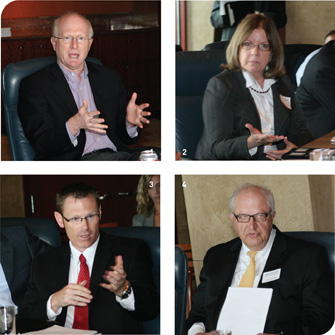
1. Mark Laney pointed out that using physicians for routine conversations was an inefficient use of an expensive health-care resource: A doctor’s time. | 2. Dayna Hodgden said about 25 percent of patients at Encompass Medical Group make good use of their available records. 3. Evan Peters saw the benefits of records access as a patient, and said his own doctor realized those, as well. | 4. Frank Devocelle questioned how the concept of “best practices” in health care would be defined—and by whom.
Stephen Salanski, a family physician with HCA Midwest and program director at the Research Family Medicine Residency program, has observed the challenge from a number of angles. HCA, a large national enterprise, was one of the first systems in the country to move to electronic records. And yet, as Salanski noted, HCA is “still having troubles with processing and moving our old records into the system.”
Paperwork, or the digital equivalent, is taking more time now, not less, and “meaningful use” is still not what it should be. “I’ve talked to colleagues in other systems,” said Salanski, “and every system seems to be lagging.”
Gary Stanton, executive director of the Women’s Healthcare Network, believes that the Internet-savvy consumer is helping drive the move to automation. One of the problems his organization has encountered in responding is the cost in time and money of training. “There’s only so much time,” he said. Getting physicians trained is “cumbersome at best,” especially for those providers lacking the proper resources.
From the consumer perspective, Rick Kahle sees “huge benefits” in getting access to relevant health information. He asked his colleagues how pushback from patients had changed relationships in the world of electronic records.
HCA is going to go on a live-line patient portal this summer, said Salanski. Patients will have access to some of their records and lab results after these have been signed off by a physician. “We’re a little nervous about what that all means,” said Salanski, “and how that changes our interactions with patients.”
Encompass Medical Group, observed CEO Dayna Hodgden, has 32 physicians who have met “meaningful use” criteria. Encompass has been using electronic medical records since 2008. “We had to commit a lot of resources and hire quite a few people to make that system work for them,” said Hodgden. To date, though, only about 25 percent of the patients have taken advantage of the patient portal to access their data. When they do use it, Hodgden added, “it has been a good thing for the patients.”
Chris Hansen sees the value in patient access, but cautioned that doctors have to be very careful about the language they use, lest patients fail to understand it. A secondary issue, of course, is reimbursement. Technically, there is none for electronic patient-doctor exchanges, even those that are time consuming.
“From the patient’s side of things,” said Evan Peters, the vice-president of network management for Cigna Health Care Plan of Mid-America, “I love this system.” An early adapter, he regularly communicates with his own physician electronically. “I love the ability to do that, but I understand there’s a cost associated with this system and something has to support that.”
Collaboration
Rick Kahle asked his colleagues whether “health-care silos” were giving way to new collaborations among health-care entities.
Mark Laney, the president and CEO of Heartland Health and a pediatric neurologist by training, explained that physicians were effectively “siloed” in their private practices and lacked electronic medical records with which to communicate. This made it hard to coordinate care.
Now, Laney believes, “We face a different kind of silo.” He attributes this to a growing “shift mentality.” Not want-ing to work the hours older physicians once did, younger physicians practice in such a way that there may be two or three “handoffs” of patients over a period of several days. This may lead to some confusion, added Laney, about “who’s my doctor?” Given this development, electronic medical records become more important as “the source of truth.” Said Laney, “I think it’s critically important that we practice evidence-based medicine.”